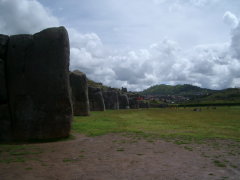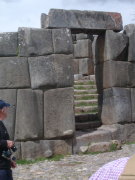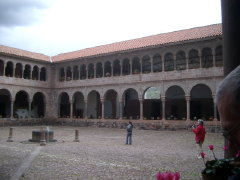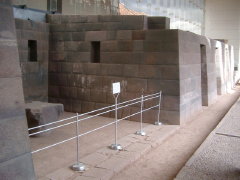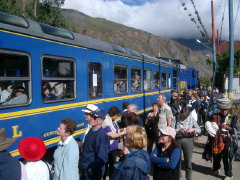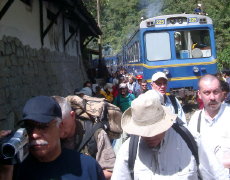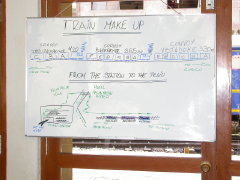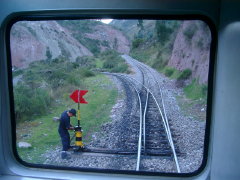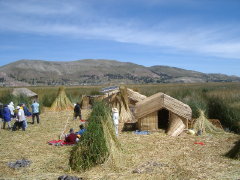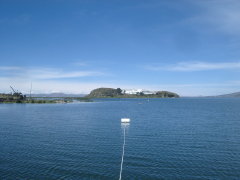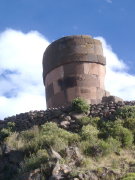Mummy
| ||
 The ancient indiginous Peruvians buried their dead in foetal position. This is a well preserved example due to the dry atmosphere. The ancient indiginous Peruvians buried their dead in foetal position. This is a well preserved example due to the dry atmosphere. |
||
Erotic pots
| ||
 The museum contained many examples of ancient Peruvian pots. They were in the form of animals, people, objects and these sexually explicit pots seemed particularly popular.
The museum contained many examples of ancient Peruvian pots. They were in the form of animals, people, objects and these sexually explicit pots seemed particularly popular. |
||
More pots
| ||
 |
||
A dog jug
| ||
 A particularly fine example of a jug in the form of a dog.
A particularly fine example of a jug in the form of a dog. |
||
Llama pots.
| ||
 |
||
The Museum
| ||
 The archaeological musem from across the square, plus the statue of Simon Bolivar.
The archaeological musem from across the square, plus the statue of Simon Bolivar. |
||
Typical house
| ||
 Typical house in a posh part of Lima. Note the cage around the front garden. Typical house in a posh part of Lima. Note the cage around the front garden. |
||
Changing of the guard
| ||
 Changing the guard at the presidential palace.
Changing the guard at the presidential palace. |
||
The real guard
| ||
 The real guards of the palace plus the band. The real guards of the palace plus the band. |
||
The main square, Lima
| ||
 The palace from across the main square. (Composite photo)
The palace from across the main square. (Composite photo) |
||
Central Lima
| ||
 Entrance to Old Post Office Arcade on Aliaga Street in Lima. Entrance to Old Post Office Arcade on Aliaga Street in Lima. |
||
Central Lima
| ||

|
||
San Francisco Monastery in Lima
| ||
 |
||
Cloisters at old monastery
| ||

|
||
Old Monastery
| ||
 |
||
Monastery Church
| ||

|
||
Monastery Cloisters
| ||
 We are led by Marguerite We are led by Marguerite |
||
Main square in Lima
| ||

|
||
Lima
| ||
 View North West showing shany town on lower slopes of mountain. View North West showing shany town on lower slopes of mountain. |
||
Lima
| ||

|
||
Lima
| ||
 Showing half built half occupied houses in front of more shanties Showing half built half occupied houses in front of more shanties |
||
Park
| ||
 The next day we started on our coach journey south heading first to Mirafiores.
View of the pier from park in Mirafiores district of Lima
The next day we started on our coach journey south heading first to Mirafiores.
View of the pier from park in Mirafiores district of Lima |
||
Park
| ||
 Lovers statue in Mirafiores park. Lovers statue in Mirafiores park. |
||
Pier at Mirafiores
| ||

|
||
Peruvian hairless dog
| ||
 |
||
Pachacamac
| ||
 Model showing the pre-inca temple complex of Pachacamac - the next stop along the coast to the south.
Model showing the pre-inca temple complex of Pachacamac - the next stop along the coast to the south. |
||
Pachacamac
| ||
 Pachacamac - Temple of the Sun Pachacamac - Temple of the Sun |
||
Pachacamac
| ||

|
||
Pachacamac
| ||
 View of encroaching shanty town. View of encroaching shanty town. |
||
Pachacamac
| ||
 Guard overlooking the site
Guard overlooking the site |
||
Pachacamac
| ||
 |
||
Pachacamac
| ||

|
||
Pachacamac
| ||
 View from temple to the Pacific View from temple to the Pacific |
||
Pachacamac
| ||

|
||
Motorway South
| ||
 |
||
Toll booths
| ||

|
||
Road safety
| ||
 |
||
Shanty town stage 1
| ||
 The houses in a shanty town start by laying down mats and matting walls.
The houses in a shanty town start by laying down mats and matting walls. |
||
Shanty town stage 2
| ||
 Then a more permanent structure is established. Then a more permanent structure is established. |
||
Shanty Town
| ||
 And then it grows into an entire town - overlooking the Pacific in this case.
And then it grows into an entire town - overlooking the Pacific in this case. |
||
Cycle Race
| ||
 Just because it's the only main road south doesn't stop it being blocked by a cycle race and this truck of supporters. Just because it's the only main road south doesn't stop it being blocked by a cycle race and this truck of supporters. |
||
Cycle race
| ||

|
||
Hacienda San Jose
| ||
 A late lunch at the Hacienda at Chincha. A late lunch at the Hacienda at Chincha. |
||
Hacienda San Jose
| ||
 The entertainment
The entertainment |
||
Hacienda San Jose
| ||
 Music from an animal's jawbone by rattling the teeth. Music from an animal's jawbone by rattling the teeth. |
||
Hacienda San Jose
| ||
 In the cellars
In the cellars |
||
Hacienda San Jose
| ||
 |
||
Hacienda San Jose
| ||
 The hacienda's church
The hacienda's church |
||
Jean
| ||
 Photographing cotton on the way from San Jose back to the main road. Photographing cotton on the way from San Jose back to the main road. |
||
Paracas
| ||
 After a long day in the coach, we finished at Paracas just south of Pisco. Overnight at a waterside hotel with pools and a fantastic view http://www.hotelparacas.com/welcome/index.html
After a long day in the coach, we finished at Paracas just south of Pisco. Overnight at a waterside hotel with pools and a fantastic view http://www.hotelparacas.com/welcome/index.html |
||
Paracas
| ||
 Our bungalow Our bungalow |
||
Paracas
| ||
 View from the bungalow
View from the bungalow |
||
Paracas
| ||
 Pelicans on the jetty Pelicans on the jetty |
||
IMGP3088
| ||
 Next day, our journey to the Ballestas Islands by speed boat.
Next day, our journey to the Ballestas Islands by speed boat. |
||
Ballestas Islands
| ||
 but first we paused at this promontery - full of pelicans. but first we paused at this promontery - full of pelicans. |
||
Ballestas Islands
| ||
 and an ancient drawing in the sand of a candelabra cactus
and an ancient drawing in the sand of a candelabra cactus |
||
Ballestas Islands
| ||
 Further out to sea, our destination. An island group, home to thousands of seabirds and their guano. Further out to sea, our destination. An island group, home to thousands of seabirds and their guano. |
||
Ballestas Islands
| ||

|
||
Ballestas Islands
| ||
 |
||
Ballestas Islands
| ||

|
||
Ballestas Islands
| ||
 including this group of penguins including this group of penguins |
||
Ballestas Islands
| ||
 and baby sealions
and baby sealions |
||
Ballestas Islands
| ||
 and not so baby sealions and not so baby sealions |
||
Ballestas Islands
| ||

|
||
Ballestas Islands
| ||
 |
||
Ballestas Islands
| ||

|
||
Ballestas Islands
| ||
 |
||
Ballestas Islands
| ||
 And yes, the boat did drive through this arch - and unlike a boat in the week of 8 May 04, didn't hit a rock and eject its passengers.
And yes, the boat did drive through this arch - and unlike a boat in the week of 8 May 04, didn't hit a rock and eject its passengers. |
||
Ballestas Islands
| ||
 sealion beach sealion beach |
||
Paracas
| ||
 Back to the hotel - the private jetty (composite photo)
Back to the hotel - the private jetty (composite photo) |
||
South of Pisco
| ||
 And then we continued South - down this road which needs to be constantly swept for sand. And then we continued South - down this road which needs to be constantly swept for sand. |
||
IMPG3174A
| ||
 even here, the shanty towns spring up
even here, the shanty towns spring up |
||
The road to Nazca
| ||
 Fellow traveller Pete videos where we're about to go.
Fellow traveller Pete videos where we're about to go. |
||
The Road to Nazca
| ||
 Yes, this really was the main road! And we haven't changed to the bus with the strengthened suspension yet. Yes, this really was the main road! And we haven't changed to the bus with the strengthened suspension yet. |
||
Nazca
| ||
 It's all right we'd pre-booked
It's all right we'd pre-booked |
||
Nazca
| ||
 our trip on a light plane to view the Nazca Lines. our trip on a light plane to view the Nazca Lines. |
||
Nazca
| ||
 The Nazca lines are scratched into the surface of the desert and are only visible from the air. The weather is such that despite being hundreds of years old, the lines are still visible.
The Nazca lines are scratched into the surface of the desert and are only visible from the air. The weather is such that despite being hundreds of years old, the lines are still visible. |
||
Nazca
| ||
 |
||
Nazca
| ||

|
||
Nazca
| ||
 Back at Nazca, these holes go down to underground water channels. Back at Nazca, these holes go down to underground water channels. |
||
The drive South East to Arequipa
| ||
 Next day, our journey continued South - pausing for a walk along the beach.
Next day, our journey continued South - pausing for a walk along the beach. |
||
The drive South East to Arequipa
| ||
 |
||
The drive South East to Arequipa
| ||
 and Howard went for a paddle in the Pacific - warmer than off Half Moon Bay in January!
and Howard went for a paddle in the Pacific - warmer than off Half Moon Bay in January! |
||
The drive South East to Arequipa
| ||
 coffee (or coca tea) stop coffee (or coca tea) stop |
||
The drive South East to Arequipa
| ||

|
||
The drive South East to Arequipa
| ||
 But it did have a tremendous view of the Pacific Ocean
But it did have a tremendous view of the Pacific Ocean |
||
The drive South East to Arequipa
| ||
 if very little shade from the intenense sun. The coach park had lots of room. if very little shade from the intenense sun. The coach park had lots of room. |
||
The drive South East to Arequipa
| ||
 Jean and cacti
Jean and cacti |
||
The drive South East to Arequipa
| ||
 More cacti and the Pacific behind. More cacti and the Pacific behind. |
||
The drive South East to Arequipa
| ||
 This is where the road went (enhanced photo)
This is where the road went (enhanced photo) |
||
The drive South East to Arequipa
| ||
 (enhanced photo) (enhanced photo) |
||
The drive South East to Arequipa
| ||
 (enhanced photo)
(enhanced photo) |
||
The drive South East to Arequipa
| ||
 Thankfully we were driving by day. Thankfully we were driving by day. |
||
The drive South East to Arequipa
| ||

|
||
The drive South East to Arequipa
| ||
 |
||
Arequipa
| ||

|
||
Arequipa
| ||
 |
||
Arequipa
| ||
 Street vendors ignoring the attempts to move them on
Street vendors ignoring the attempts to move them on |
||
Arequipa - Santa Catalina Convent
| ||

|
||
Arequipa - Santa Catalina Convent
| ||
 |
||
Arequipa - Santa Catalina Convent
| ||

|
||
Arequipa - Santa Catalina Convent
| ||
 |
||
Arequipa - Santa Catalina Convent
| ||

|
||
Arequipa - Santa Catalina Convent
| ||
 |
||
Arequipa - Santa Catalina Convent
| ||

|
||
Arequipa - Santa Catalina Convent
| ||
 |
||
Arequipa - Plaza des Armes
| ||
 The main square in Arequipa.
The main square in Arequipa. |
||
Arequipa
| ||
 La Compania church, just off the Plaza des Armes La Compania church, just off the Plaza des Armes |
||
Arequipa
| ||
 La Compania church, just off the Plaza des Armes
La Compania church, just off the Plaza des Armes |
||
Arequipa
| ||
 La Compania church, just off the Plaza des Armes - close up of detail of carving La Compania church, just off the Plaza des Armes - close up of detail of carving |
||
Arequipa
| ||
 La Compania church, interior
La Compania church, interior |
||
Arequipa
| ||
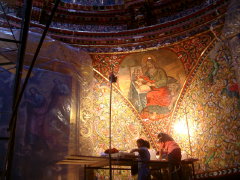 La Compania church, interior - back chapel being restored La Compania church, interior - back chapel being restored |
||
Arequipa
| ||
 Cloisters next door to the church, now mainly up-market alpacca shops.
Cloisters next door to the church, now mainly up-market alpacca shops. |
||
Arequipa
| ||
 Collonade covering pavement round Plaza des Armes Collonade covering pavement round Plaza des Armes |
||
Vicunias on road to Colca Canyon
| ||

|
||
Our hitchhikers take their seats
| ||

|
||
The road to Chivay
| ||
 |
||
The inevitable tourist trap with alpacca
| ||

|
||
We went the other way
| ||
 Our hitchhiking policemen leave on foot for the rest of their journey! Our hitchhiking policemen leave on foot for the rest of their journey! |
||
Spot the rabbit
| ||
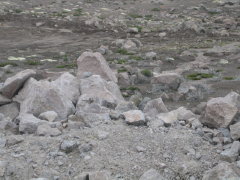
|
||
Spot the main road
| ||
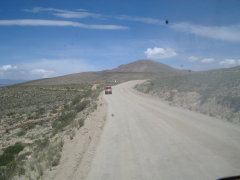 |
||
Chivay market
| ||
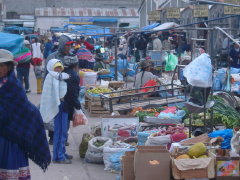
|
||
near Chivay
| ||
 A stop on the way up the Colca Valley to the Colca Canyon A stop on the way up the Colca Valley to the Colca Canyon |
||
near Chivay
| ||
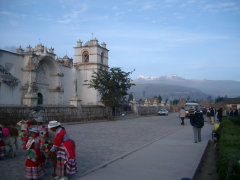
|
||
near Chivay
| ||
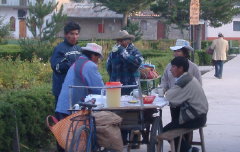 They were breakfasting on a porridgey drink and bread. They were breakfasting on a porridgey drink and bread. |
||
Colca Valley
| ||
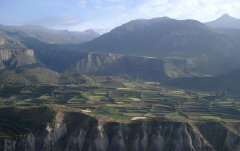 Terracing for cultivation
Terracing for cultivation |
||
Waiting for the condors
| ||
 We had a two hour stop at the point where Andean condors regularly soar in the thermals above the Colca Canyon. We had a two hour stop at the point where Andean condors regularly soar in the thermals above the Colca Canyon. |
||
Andean condor
| ||
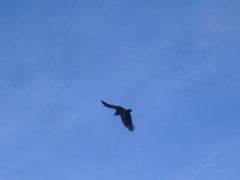 They turned up for the last 15 minutes!
They turned up for the last 15 minutes! |
||
IMGP3330
| ||
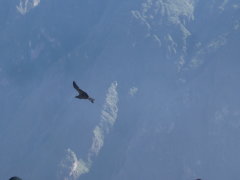 |
||
IMPG3330A
| ||
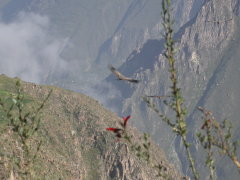
|
||
IMGP3335
| ||
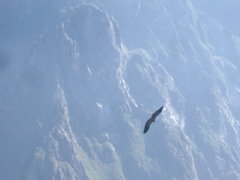 |
||
IMGP3340
| ||
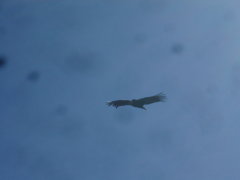
|
||
IMGP3346
| ||
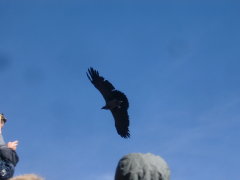 |
||
The journey back
| ||
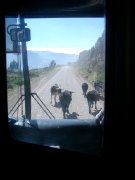
|
||
IMGP3350
| ||
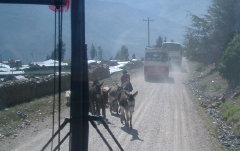 |
||
The Colca Valley
| ||
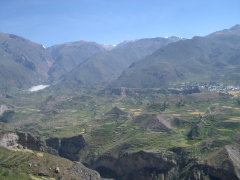
|
||
The Colca Valley
| ||
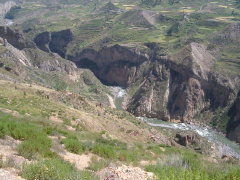 Looking down to the river at the valley floor Looking down to the river at the valley floor |
||
Road and valley
| ||
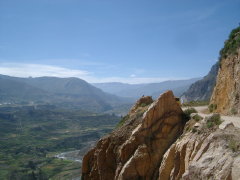 The road was fairly exciting at times - local drivesr were quite happy to overtake in sections like this.
The road was fairly exciting at times - local drivesr were quite happy to overtake in sections like this. |
||
IMGP3360J1
| ||
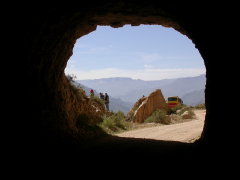 |
||
The highest point
| ||
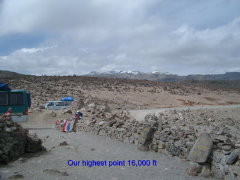 The highest point of our journey back down to Arequipa from the Colca Valley. In fact it was higher than 16,000 feet.
The highest point of our journey back down to Arequipa from the Colca Valley. In fact it was higher than 16,000 feet. |
||
Dorking holds the bus together
| ||
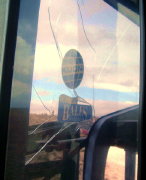 The door window of the bus was held together entirely by the stickers of Bales and Kuoni - both based in Dorking. The door window of the bus was held together entirely by the stickers of Bales and Kuoni - both based in Dorking. |
||
Cusco
| ||
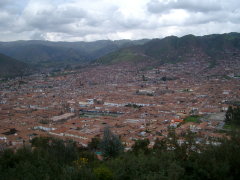 The next day we flew from Arequipa to Cusco. This is the view down into Cusco from the mountain drive to Yukay.
The next day we flew from Arequipa to Cusco. This is the view down into Cusco from the mountain drive to Yukay. |
||
Near Cusco
| ||
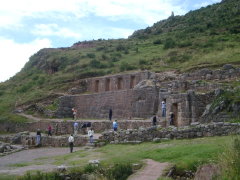 On the way to our hotel we visited these ruins of an Inca staging post. They were built at intervals along the Inca Trail from Cusco to Machu Pichu. On the way to our hotel we visited these ruins of an Inca staging post. They were built at intervals along the Inca Trail from Cusco to Machu Pichu. |
||
Inca engineering
| ||
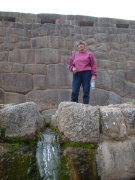 This water channel sends the water in exactly the right direction. (Jean adds scale)
This water channel sends the water in exactly the right direction. (Jean adds scale) |
||
Photo opportunity
| ||
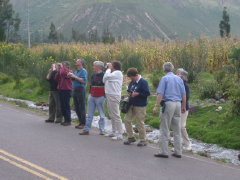 On the way to Ollantaytambo we stopped to look at the burial tombs . . . On the way to Ollantaytambo we stopped to look at the burial tombs . . . |
||
Burial tombs
| ||
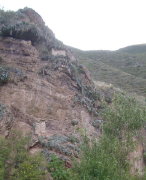 . . . built into the mountainside.
. . . built into the mountainside. |
||
Ollantaytambo
| ||
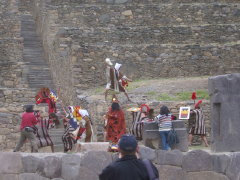 Our visit to the impressive Inca ruins of Ollantaytambo coincided with this film crew shooting a film on the Inca/Spanish war. Our visit to the impressive Inca ruins of Ollantaytambo coincided with this film crew shooting a film on the Inca/Spanish war. |
||
Ollantaytambo
| ||
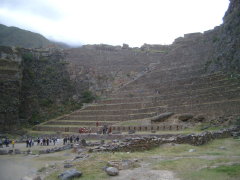 I did say impressive - and all at around 10,000 feet, so climbing was slow going.
I did say impressive - and all at around 10,000 feet, so climbing was slow going. |
||
Ollantaytambo
| ||
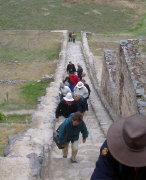 We struggle up the ruins We struggle up the ruins |
||
Ollantaytambo
| ||
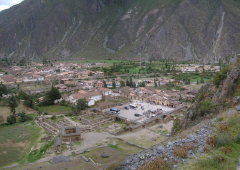 But the view is well worth the climb
But the view is well worth the climb |
||
Ollantaytambo
| ||
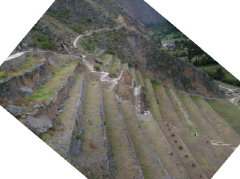 |
||
Ollantaytambo
| ||
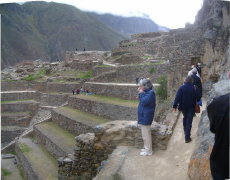 Not for those with a fear of hights.
Not for those with a fear of hights. |
||
Ollantaytambo
| ||
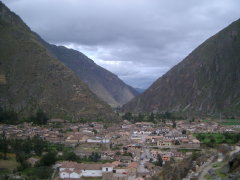 |
||
Ollantaytambo
| ||
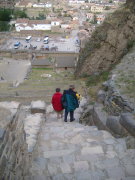
|
||
Ollantaytambo
| ||
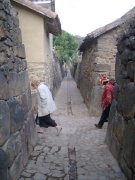 In the village below the ruins. In the village below the ruins. |
||
Village house
| ||
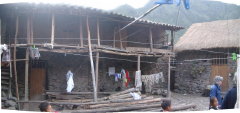 This house is still lived in in the traditional way (mainly for tourists).
This house is still lived in in the traditional way (mainly for tourists). |
||
Village house
| ||
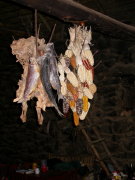 |
||
Village house
| ||
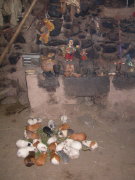 Lunch - guinea pigs are a popular local food.
Lunch - guinea pigs are a popular local food. |
||
Village house
| ||
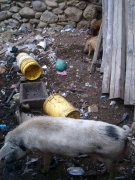 The pigs lived outside - in the rubbish tip. The pigs lived outside - in the rubbish tip. |
||
Pisac Market
| ||
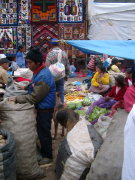 A very large market combining genuine local needs (meat, fruit, vegetables, bakeries) and handcrafted tourist souvenirs.
A very large market combining genuine local needs (meat, fruit, vegetables, bakeries) and handcrafted tourist souvenirs. |
||
Pisac Market
| ||
 |
||
Pisac Market
| ||
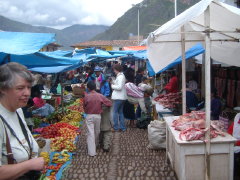
|
||
Pisac Market
| ||
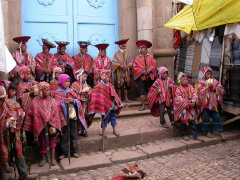 Outside the church traditionally dressed boys blow conch shells to herald the loocal mayors. I suspect the main reason they do this is to charge the tourists for photos. Outside the church traditionally dressed boys blow conch shells to herald the loocal mayors. I suspect the main reason they do this is to charge the tourists for photos. |
||
Pisac Market
| ||
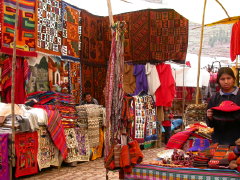
|
||
Pisac Market
| ||
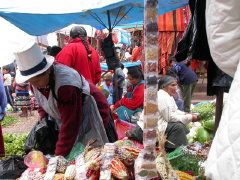 |
||
Pisac Market
| ||
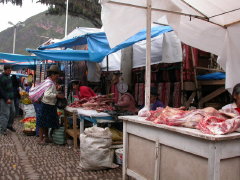 Butchers
Butchers |
||
Pisac Market
| ||
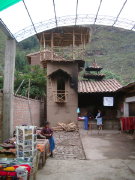 Bakers Bakers |
||
Pisac Market
| ||
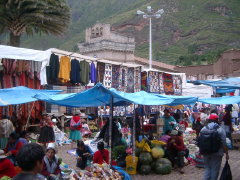
|
||
Pisac Market
| ||
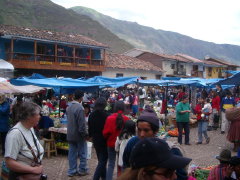 |
||
Pisac Market
| ||
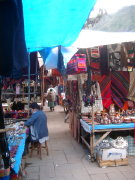
|
||
Sacsayhuaman
| ||
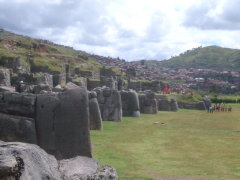 You can just see the film crew again - filming more about the Incas. You can just see the film crew again - filming more about the Incas. |
||
Sacsayhuaman
| ||
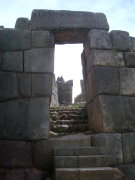
|
||
Sunday Lunch
| ||
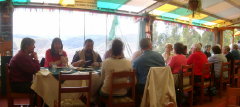 This shows the traditional Peruvian restaurant overlooking Cusco.
The next table did have guinea pig - skinned and gutted then roasted and served whole (head and legs included). This shows the traditional Peruvian restaurant overlooking Cusco.
The next table did have guinea pig - skinned and gutted then roasted and served whole (head and legs included). |
||
Santo Domingo Church,
| ||
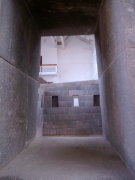
|
||
Santo Domingo Church,
| ||
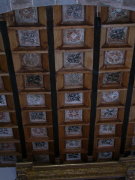 |
||
Santo Domingo Church,
| ||
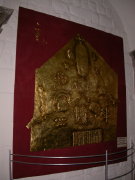
|
||
Cusco Plaza des Armes
| ||
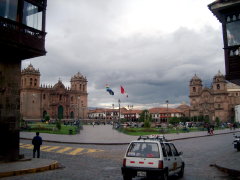 The large square at the heart of Cusco The large square at the heart of Cusco |
||
Cusco Plaza des Armes
| ||
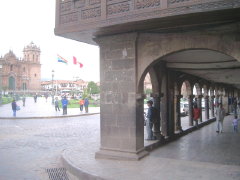 Surrounded by cloistered pavements on 3 sides.
Surrounded by cloistered pavements on 3 sides. |
||
Cusco Plaza des Armes
| ||
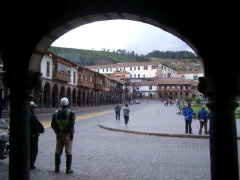 With traffic police With traffic police |
||
Cusco Plaza des Armes
| ||
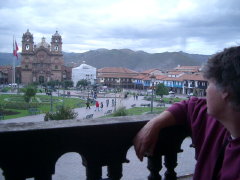 and lots of first floor restaurants where you can sit and look out whilst paying very little for a coffee.
and lots of first floor restaurants where you can sit and look out whilst paying very little for a coffee. |
||
Yucay
| ||
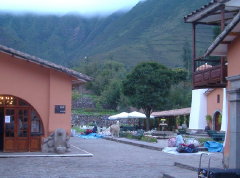 Our hotel near Cusco Our hotel near Cusco |
||
Yucay
| ||

|
||
Yucay
| ||
 |
||
Yucay
| ||
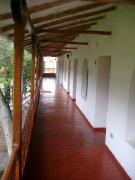
|
||
Machu Picchu
| ||
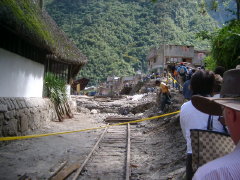 |
||
Machu Picchu
| ||
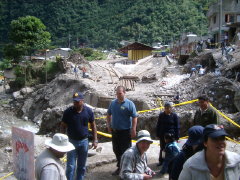 The landsllide The landsllide |
||
Machu Picchu
| ||
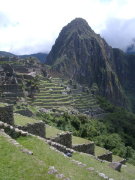
|
||
Machu Picchu
| ||
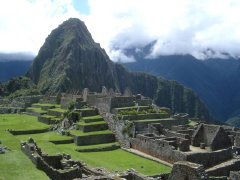 |
||
Machu Picchu
| ||
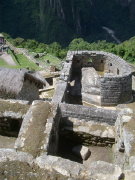
|
||
Machu Picchu
| ||
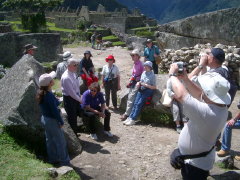 Our guide tells us a facinating fact about something Our guide tells us a facinating fact about something |
||
Machu Picchu
| ||
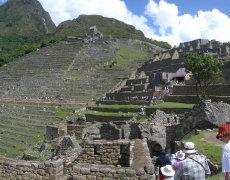 Looking towards the watchman's hut
Looking towards the watchman's hut |
||
Machu Picchu
| ||
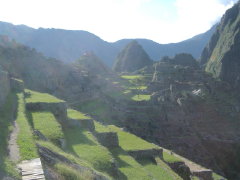 |
||
Machu Picchu
| ||
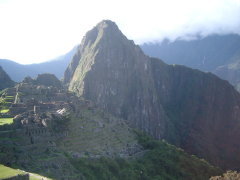
|
||
Machu Picchu
| ||
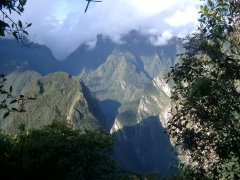 |
||
Machu Picchu
| ||
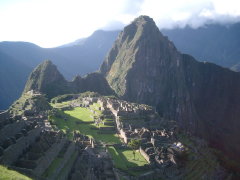
|
||
Machu Picchu
| ||
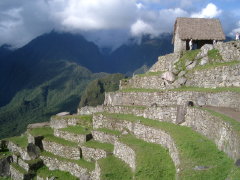 |
||
Machu Picchu
| ||
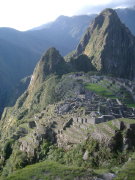
|
||
Machu Picchu
| ||
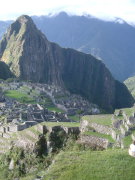 |
||
Machu Picchu
| ||
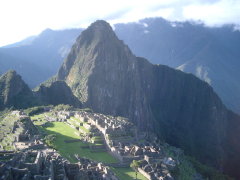
|
||
Machu Picchu
| ||
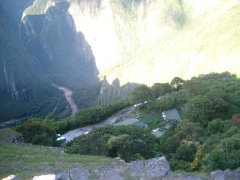 |
||
Machu Picchu
| ||
 Llamas on the upper terraces
Llamas on the upper terraces |
||
Machu Picchu
| ||
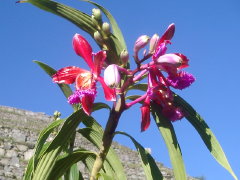 |
||
Machu Picchu
| ||
 The view up to the Sun Gate
The view up to the Sun Gate |
||
Machu Picchu
| ||
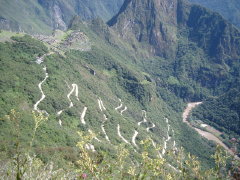 The road up from Aguas Calientes, with Machu Picchu and our hotel at the top. No, the buses didn't slow down for blind bends, yes it was exciting when two buses met. The road up from Aguas Calientes, with Machu Picchu and our hotel at the top. No, the buses didn't slow down for blind bends, yes it was exciting when two buses met. |
||
Machu Picchu
| ||
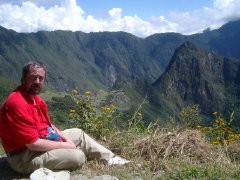 Howard, somewhat exhausted having walked up from Machu Picchu (in distance in the middle).
Howard, somewhat exhausted having walked up from Machu Picchu (in distance in the middle). |
||
Machu Picchu
| ||
 |
||
Machu Picchu
| ||
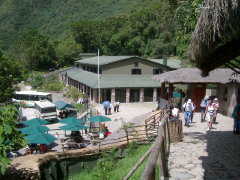 Our hotel from the entrance to the site
Our hotel from the entrance to the site |
||
Aguas Calientes Market
| ||
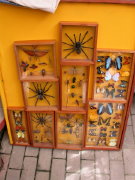 Just the gift for an arachnaphobe. The market was the inevitable retail opportunity just before boarding the train back to Cusco. Just the gift for an arachnaphobe. The market was the inevitable retail opportunity just before boarding the train back to Cusco. |
||
Aguas Calientes Market
| ||
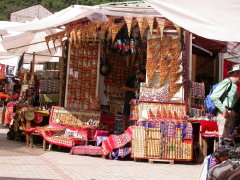 Pan Pipes (the sound of which we were thoroughly sick of by this time)
Pan Pipes (the sound of which we were thoroughly sick of by this time) |
||
Aguas Calientes
| ||
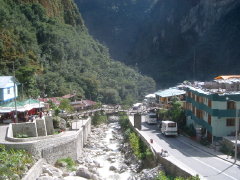 |
||
Aguas Calientes
| ||
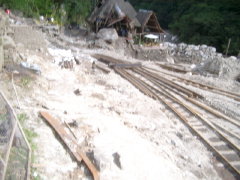 The end of the line.
The end of the line. |
||
Aguas Calientes
| ||
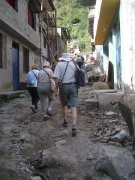 Walking through the landslip area back to the train. Walking through the landslip area back to the train. |
||
Aguas Calientes
| ||
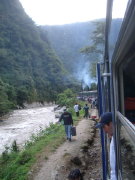 Boarding the train
Boarding the train |
||
Train journey back to Cusco
| ||
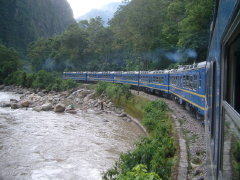 The train runs alongside the Urubamba river though a high sided gorge. The train runs alongside the Urubamba river though a high sided gorge. |
||
Train journey back to Cusco
| ||
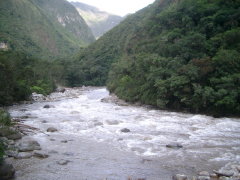
|
||
Train journey back to Cusco
| ||
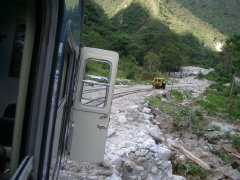 |
||
Train journey back to Cusco
| ||
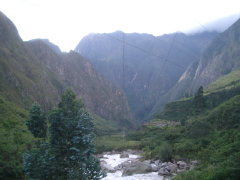
|
||
Train journey back to Cusco
| ||
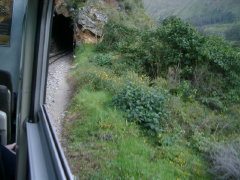 |
||
Train journey back to Cusco
| ||
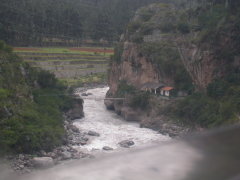
|
||
Train journey back to Cusco
| ||
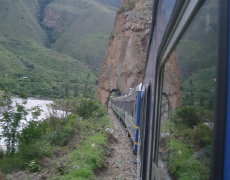 |
||
Train journey back to Cusco
| ||
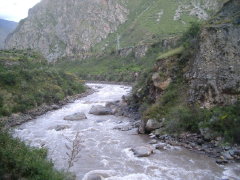
|
||
Cusco
| ||
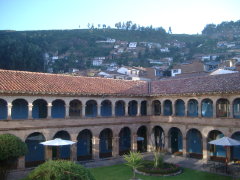 Our hotel - The Monasterio
Our hotel - The Monasterio |
||
Cusco
| ||
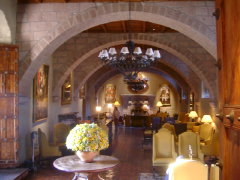 The hotel lobby! The hotel lobby! |
||
Cusco
| ||
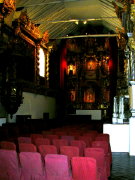 The hotel conference room/lounge converted from the old monastery church.
The hotel conference room/lounge converted from the old monastery church. |
||
Train journey from Cusco to Lake Titicaca
| ||
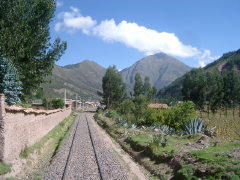 |
||
Train journey from Cusco to Lake Titicaca
| ||
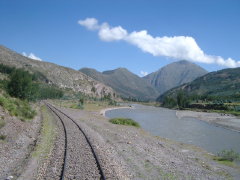 The first half of the journey is dominated by magnificent Andean mountains, towering over the deep valleys of the meandering Huatanay River.
The first half of the journey is dominated by magnificent Andean mountains, towering over the deep valleys of the meandering Huatanay River. |
||
Train journey from Cusco to Lake Titicaca
| ||
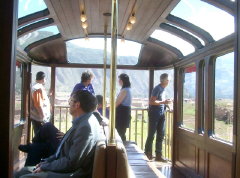 The observation car The observation car |
||
Train journey from Cusco to Lake Titicaca
| ||
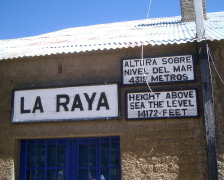 Highest point of the journey
Highest point of the journey |
||
Train journey from Cusco to Lake Titicaca
| ||
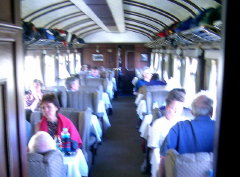 GNER isn't quite up to this standard. (NB Single PeruRail 1st class all day trip incl lunch US$90. Tourist/backpacker class US$14!) GNER isn't quite up to this standard. (NB Single PeruRail 1st class all day trip incl lunch US$90. Tourist/backpacker class US$14!) |
||
Train journey from Cusco to Lake Titicaca
| ||
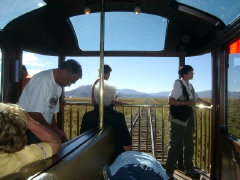
|
||
Train journey from Cusco to Lake Titicaca
| ||
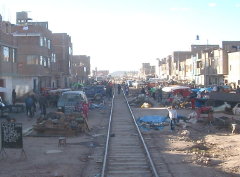 Passing through Juliaca. Passing through Juliaca. |
||
Train journey from Cusco to Lake Titicaca
| ||
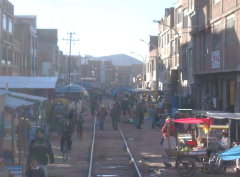
|
||
Train journey from Cusco to Lake Titicaca
| ||
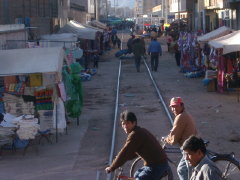 |
||
Train journey from Cusco to Lake Titicaca
| ||
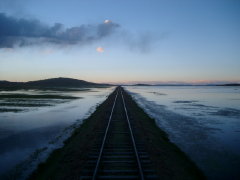 Looking back as we cross the shores of lake Titicaca at dusk.
Looking back as we cross the shores of lake Titicaca at dusk. |
||
Lake Titicaca
| ||
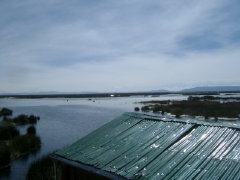 Looking towards the reed islands Looking towards the reed islands |
||
Train journey from Cusco to Lake Titicaca
| ||
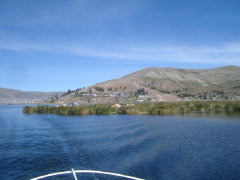
|
||
Train journey from Cusco to Lake Titicaca
| ||
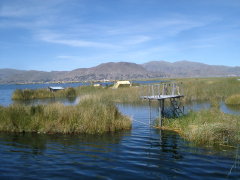 Floating reed islands. Floating reed islands. |
||
Lake Titicaca
| ||
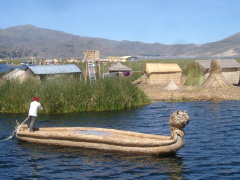 Reed islanders' typical reed boat Reed islanders' typical reed boat |
||
Lake Titicaca
| ||
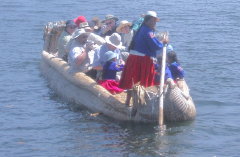 The reed boats are of course nothing to do with extracting dollars from tourists.
The reed boats are of course nothing to do with extracting dollars from tourists. |
||
The Altiplano
| ||
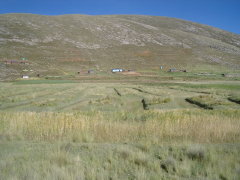 Agriculture at 12,000 feet.
Agriculture at 12,000 feet. |
||
The Altiplano
| ||
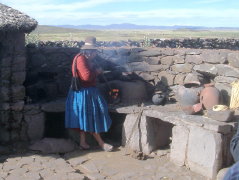 Resident of farming community. Resident of farming community. |
||
The Altiplano
| ||
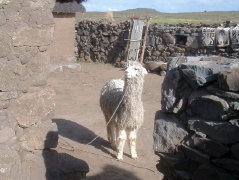 Another resident
Another resident |
||
The Altiplano
| ||
 |
||
Chullpas of Sillustani
| ||
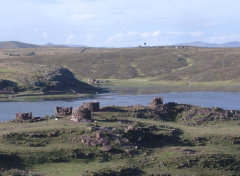 |
||
Chullpas of Sillustani
| ||
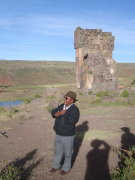 Our guide for the Puno area
Our guide for the Puno area |
||
Lake Umayo
| ||
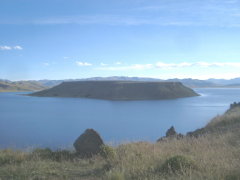 |
||
Chullpas of Sillustani
| ||
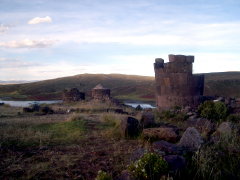
|
||
Lima
| ||
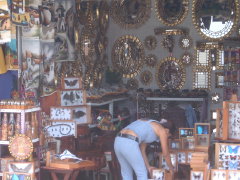 The Indian Market The Indian Market |
||
Lima
| ||
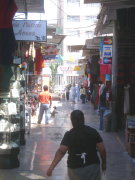 All credit cards accepted
All credit cards accepted |
||
Lima
| ||
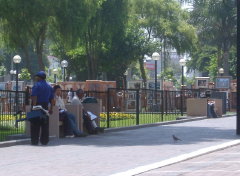 Shoe shine and pavement art gallery Shoe shine and pavement art gallery |
||
Lima
| ||
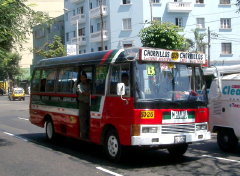 Typical bus with conductor leaning out calling to encourage more passengers.
Typical bus with conductor leaning out calling to encourage more passengers. |
||
Lima
| ||
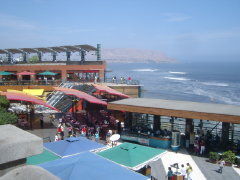 The posh cliffside shops and restaurants of the Miraflores district of Lima The posh cliffside shops and restaurants of the Miraflores district of Lima |
||
Lima
| ||
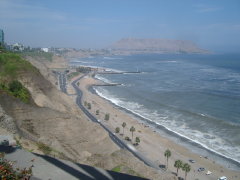 View from Miraflores
View from Miraflores |
||
Lima
| ||
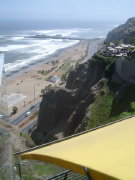 |
||
Lima
| ||
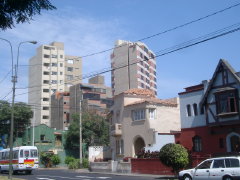 Side streets in Miraflores
Side streets in Miraflores |
||
Lima
| ||
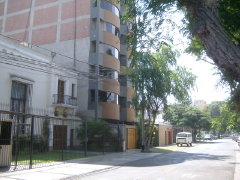 Miraflores Miraflores |
||
Lima
| ||
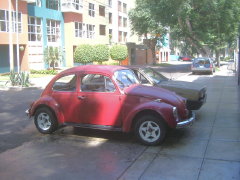
|
||
Lima
| ||
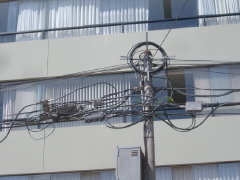 Local power distribution Local power distribution |
||
Lima
| ||
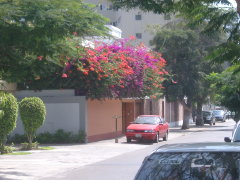
|
||
Amsterdam
| ||
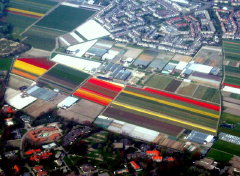 View from the plane View from the plane |
||
Amsterdam
| ||
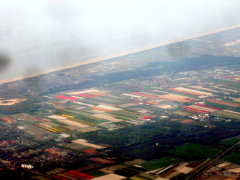
|
||
London
| ||
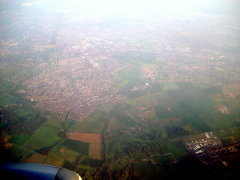 Holding over Romford Holding over Romford |
||
London
| ||
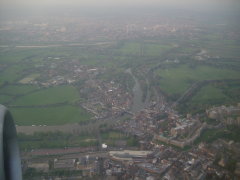 Approach via Windsor
Approach via Windsor |
||
London
| ||
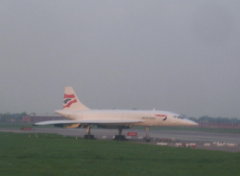 On the outskirts of the airport On the outskirts of the airport |
||








